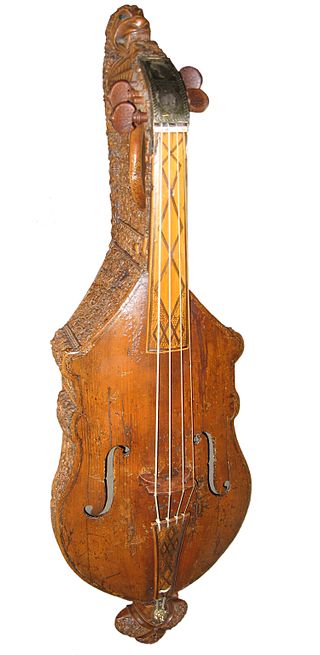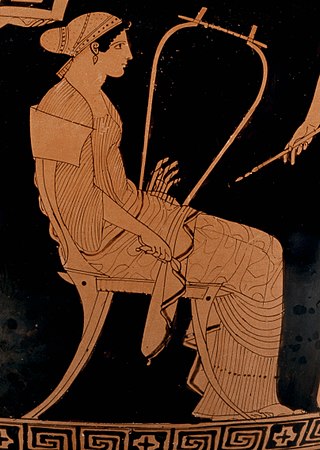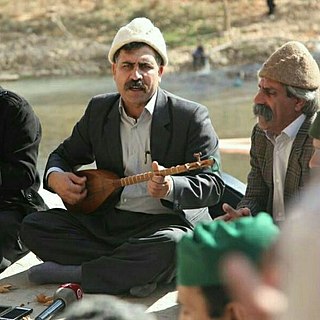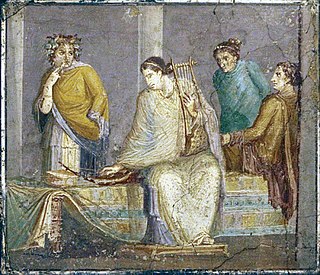
The guitar is a stringed musical instrument, that is usually fretted and typically has six or twelve strings. It is usually held flat against the player's body and played by strumming or plucking the strings with the dominant hand, while simultaneously pressing selected strings against frets with the fingers of the opposite hand. A plectrum or individual finger picks may also be used to strike the strings. The sound of the guitar is projected either acoustically, by means of a resonant chamber on the instrument, or amplified by an electronic pickup and an amplifier.

In musical instrument classification, string instruments or chordophones, are musical instruments that produce sound from vibrating strings when a performer plays or sounds the strings in some manner.

The lyre is a stringed musical instrument that is classified by Hornbostel–Sachs as a member of the lute family of instruments. In organology, a lyre is considered a yoke lute, since it is a lute in which the strings are attached to a yoke that lies in the same plane as the sound table, and consists of two arms and a crossbar.

The oud is a Middle Eastern short-neck lute-type, pear-shaped, fretless stringed instrument, usually with 11 strings grouped in six courses, but some models have five or seven courses, with 10 or 13 strings respectively.

The crwth, also called a crowd or rote or crotta, is a bowed lyre, a type of stringed instrument, associated particularly with Welsh music, now archaic but once widely played in Europe. Four historical examples have survived and are to be found in St Fagans National Museum of History (Cardiff); National Library of Wales (Aberystwyth); Warrington Museum & Art Gallery; and the Museum of Fine Arts, Boston (US).

The rebab is the name of several related string instruments that independently spread via Islamic trading routes over much of North Africa, Southeast Asia, the Middle East, and parts of Europe. The instrument is typically bowed, but is sometimes plucked. It is one of the earliest known bowed instruments, named no later than the 8th century, and is the parent of many bowed and stringed instruments.

The Guitar fiddle or Troubadour Fiddle is a modern name bestowed retroactively upon certain precursors of the violin possessing characteristics of both guitar and fiddle. The name guitar fiddle is intended to emphasize the fact that the instrument in the shape of the guitar, which during the Middle Ages represented the most perfect principle of construction for stringed instruments with necks, adopted at a certain period the use of the bow from instruments of a less perfect type, the rebab and its hybrids.

The citole was a string musical instrument, closely associated with the medieval fiddles and commonly used from 1200–1350. It was known by other names in various languages: cedra, cetera, cetola, cetula, cistola, citola, citula, citera, chytara, cistole, cithar, cuitole, cythera, cythol, cytiole, cytolys, gytolle, sitole, sytholle, sytole, and zitol. Like the modern guitar, it was manipulated at the neck to get different notes, and picked or strummed with a plectrum. Although it was largely out of use by the late 14th century, the Italians "re-introduced it in modified form" in the 16th century as the cetra, and it may have influenced the development of the guitar as well. It was also a pioneering instrument in England, introducing the populace to necked, plucked instruments, giving people the concepts needed to quickly switch to the newly arriving lutes and gitterns. Two possible descendant instruments are the Portuguese guitar and the Corsican Cetera, both types of cittern.

The barbiton, or barbitos, is an ancient stringed instrument related to the lyre known from Greek and Roman classics.

The term Tanbur can refer to various long-necked string instruments originating in Mesopotamia, Southern or Central Asia. According to the New Grove Dictionary of Music and Musicians, "terminology presents a complicated situation. Nowadays the term tanbur is applied to a variety of distinct and related long-necked lutes used in art and folk traditions. Similar or identical instruments are also known by other terms." These instruments are used in the traditional music of Iran, India, Kurdistan, Armenia, Afghanistan, Azerbaijan, Pakistan, Turkey, Tajikistan, Kazakhstan, and Uzbekistan.

The cythara is a wide group of stringed instruments of medieval and Renaissance Europe, including not only the lyre and harp but also necked, string instruments. In fact, unless a medieval document gives an indication that it meant a necked instrument, then it likely was referring to a lyre. It was also spelled cithara or kithara and was Latin for the Greek lyre. However, lacking names for some stringed instruments from the medieval period, these have been referred to as fiddles and citharas/cytharas, both by medieval people and by modern researchers. The instruments are important as being ancestors to or influential in the development of a wide variety of European instruments, including fiddles, vielles, violas, citoles and guitars. Although not proven to be completely separate from the line of lute-family instruments that dominated Europe, arguments have been made that they represent a European-based tradition of instrument building, which was for a time separate from the lute-family instruments.

The kithara, or Latinized cithara, was an ancient Greek musical instrument in the yoke lutes family. It was a seven-stringed professional version of the lyre, which was regarded as a rustic, or folk instrument, appropriate for teaching music to beginners. As opposed to the simpler lyre, the cithara was primarily used by professional musicians, called kitharodes. In modern Greek, the word kithara has come to mean "guitar", a word which etymologically stems from kithara.

The Byzantine lyra or lira was a medieval bowed string musical instrument in the Byzantine Empire. In its popular form, the lyra was a pear-shaped instrument with three to five strings, held upright and played by stopping the strings from the side with fingernails. The first known depiction of the instrument is on a Byzantine ivory casket, preserved in the Bargello in Florence. Versions of the Byzantine lyra are still played throughout the former lands of the Byzantine Empire: Greece, Crete, Albania, Montenegro, Serbia, Bulgaria, North Macedonia, Croatia, Italy and Armenia.
The Kemençe of the Black Sea is a Greek and Turkish traditional musical instrument. It belongs to the category of stringed bowed musical instruments. It has three strings, usually tuned to perfect fourths, usually tuned B-E-A. It is the pre-eminent musical folk instrument of the Greeks of Pontus. It seems to have been invented during the Byzantine years, between the 11th and 12th centuries. The instrument is made of different types of wood.

The classicalkemenche, Armudî kemençe or Politiki lyra is a pear-shaped bowed instrument that derived from the medieval Greek Byzantine lyre.

Music technology is the study or the use of any device, mechanism, machine or tool by a musician or composer to make or perform music; to compose, notate, playback or record songs or pieces; or to analyze or edit music.

Mechanical music technology is the use of any device, mechanism, machine or tool by a musician or composer to make or perform music; to compose, notate, play back or record songs or pieces; or to analyze or edit music. The earliest known applications of technology to music was prehistoric peoples' use of a tool to hand-drill holes in bones to make simple flutes. Ancient Egyptians developed stringed instruments, such as harps, lyres and lutes, which required making thin strings and some type of peg system for adjusting the pitch of the strings. Ancient Egyptians also used wind instruments such as double clarinets and percussion instruments such as cymbals. In Ancient Greece, instruments included the double-reed aulos and the lyre. Numerous instruments are referred to in the Bible, including the horn, pipe, lyre, harp, and bagpipe. During Biblical times, the cornet, flute, horn, organ, pipe, and trumpet were also used. During the Middle Ages, hand-written music notation was developed to write down the notes of religious Plainchant melodies; this notation enabled the Catholic church to disseminate the same chant melodies across its entire empire.

Lutes are stringed musical instruments that include a body and "a neck which serves both as a handle and as a means of stretching the strings beyond the body".

The psalterion is a stringed, plucked instrument, an ancient Greek harp. Psalterion was a general word for harps in the latter part of the 4th century B.C. It meant "plucking instrument".


















